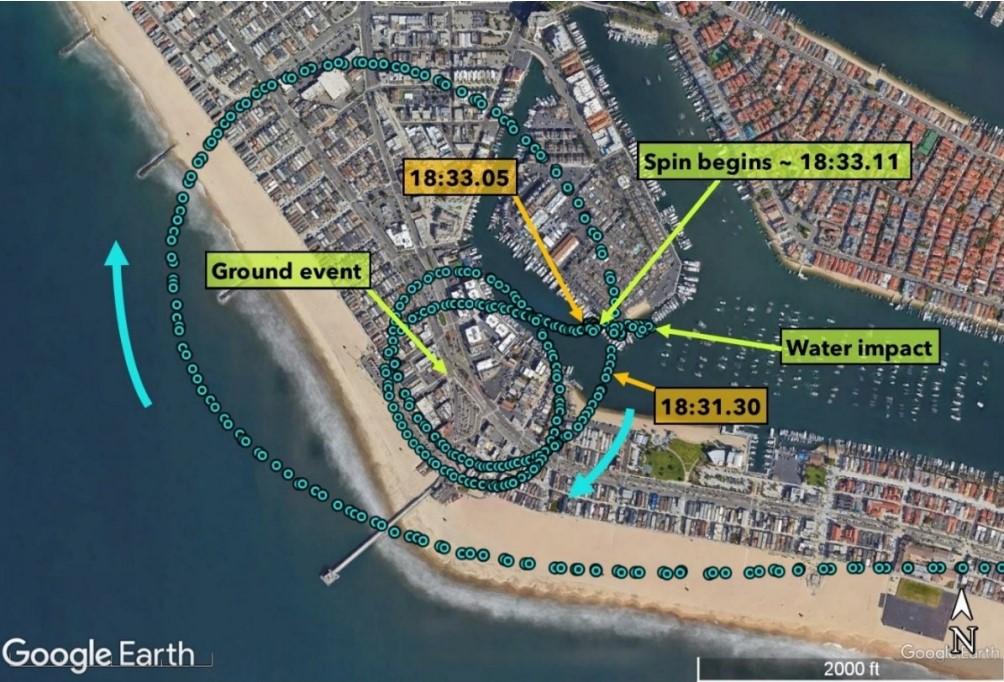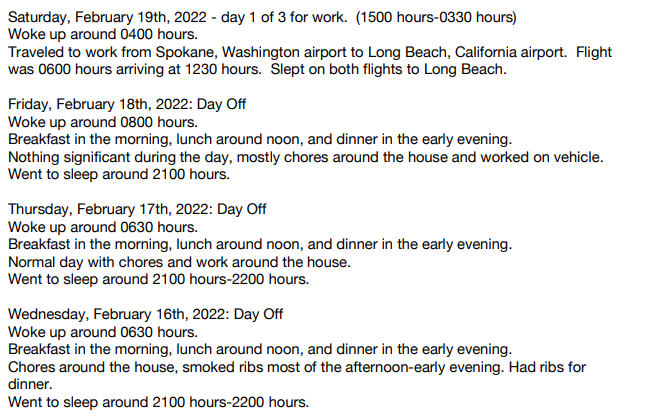Police Helicopter Unanticipated Yaw & Fatal Water Impact (Huntington Beach Police Department MD520N N521HB)
On 19 February 2022 at 18:34 Local Time MD Helicopters 500N (MD520N) N521HB of Huntington Beach Police Department (HBPD) was destroyed when it impacted the water off Newport Beach, California in a Loss of Control – Inflight (LOC-I) accident. The police pilot escaped with minor injuries but the police Tactical Flight Officer (TFO) was fatally injured.

Wreckage of Huntington Beach Police Department (HBPD) MD Helicopters 500N (MD520N) N521HB (Credit: NTSB)
The Huntington Beach Police Air Support Unit was formed in 1968, only the fifth in the US. In 1992 they introduced their first MD520N and became an all MD520N fleet in 2002. Instead of having a conventional tail rotor for anti-torque control the MD520N has a NOTAR (NO TAil Rotor) design with a variable thruster and ducted fan system. In 2023, the unit changed over to the tail rotor-equipped MD530F].
The Accident Flight
The US National Transportation Safety Board (NTSB) issued their safety investigation report on 14 December 2023 into the Newport Beach accident.
The law-enforcement helicopter was performing right turns at night over an waterfront peninsula supporting officers attending a street fight involving up to 10 people.
The pilot estimated “that they were flying about 500-600 agl, which is standard practice” when the helicopter yawed aggressively to the right and he…
…immediately applied full left foot pedal and forward cyclic to arrest the rotation, but there was no response. He then applied right pedal to see if the pedals had malfunctioned, and observing no change, he reverted to full left pedal. He continued to apply corrective control inputs, but the helicopter did not respond and began to progress into a spinning descent.

Final Flight Path of Huntington Beach Police Department (HBPD) MD Helicopters 500N (MD520N) N521HB (Credit: Google/NTSB)
The pilot stated that the rotation became more aggressive, and he began to modulate the throttle, collective, and cyclic controls to try to arrest the rotation rate. He stated that his efforts appeared to be partially effective, as the helicopter appeared to respond; however, because it was dark, he had no horizon or accurate external visual reference as the ground approached. The engine continued to operate, and he chose not to perform an autorotation because the area was heavily populated. He then had a sense that impact was imminent, so he pulled the collective control in an effort to bleed off airspeed.
The helicopter impacted the water…
…on the TFO’s side in a downward right rotation. The pilot recalled a sudden smash and saw water and glass coming toward him as the canopy shattered. He felt the rotor blades hitting the water, everything then stopped, and within a few seconds he was submerged.
The Pilot’s Underwater Escape & the Attempted Rescue of the TFO
The police department’s personnel…
…fly with a full tactical vest, an inflatable “horse collar”, Submersible Systems “Spare Air” [Compressed Air – Emergency Breathing System] tank, gun, radio, magazines, and handcuffs, all carried on their chest.
The pilot held on to the collective as a reference point. He recalled that:
He waited for the helicopter to stop moving, grabbed the Spare Air mouthpiece, cleared it, and started
to breath. Holding the collective with one hand he reached down and released his seat harness. His eyes were closed, and he was able to move by feel. He did not recall opening the door.. He exited the helicopter and was upside down. He tried to relax and remained motionless waiting for himself to rise. He realized he was still attached by the helmet cord, so he disconnected it and started to slowly ascend with his hand up over his head.He attributed his experience as a SCUBA instructor as very beneficial in his ability to orient himself in the dark water. He reached the surface and could see the tail boom. Everything was silent and he could see the flashing tail beacon. He did not inflate his vest…
By now the first rescuers were arriving.
He was asked how long the spare air lasted, and stated that although the manufacturer advertises 3-5 minutes, he suspects less because he was breathing hard. He did not run out of air during the accident, and he threw the unit to one of the rescuers who was a lifeguard, for his use.
He…was in no doubt that the spare air system saved his life.
A witness, who initially assisted the pilot, dived back in to search for the TFO. He used the pilot’s air bottle and reported that the water visibility was about 20 inches. He found a door handle and rotated it 90° and the door opened. When he entered, he felt initially what he thought was the TFO, but it was a tactical bag. He came back to the surface and the pilot called out that he was on the wrong side of the helicopter, so he dived again to the other side but was not able to find the door.
NTSB note that:
Both the pilot and TFO had completed “Dunker Training” using a shallow water egress trainer system (SWET) on January 27, 2020. The training used equipment in the shallow end of a swimming pool and taught basic underwater escape procedures dealing with seat belts, brace positions, reference points, and exits. The training included use of the emergency breathing device.
After a few minutes, the helicopter was pulled closer to the shore by a truck, revealing the cabin. A diver stated that the forward left door was closed, and its window was gone, and he could see that the TFO was halfway out of the window. He appeared uninjured, his seat harness was unbuckled, and his helmet cord was already disconnected.
They attempted to pull him out, but it became apparent that his leg was stuck. They pushed him back in and tried again, and this time he came out easily.
The TFO was still wearing his helmet and vest. The inflatable section of the vest had not been deployed, and its trigger handle had not been pulled. The protective cover of his air bottle mouthpiece had been removed; the air valve was open, and the bottle was empty.
The NTSB Safety Investigation
Examination of wreckage revealed no pre-impact anomalies of the helicopter.
Although the pilot reported that the helicopter was traveling at a speed of about 50 knots before the spins began, review of flight track data and onboard imaging revealed that, after factoring relative wind, the helicopter had essentially transitioned to a hover shortly before the event started and was flying almost perpendicular to the direction of travel for about 30 seconds before entering the rotation.

This discrepancy was likely because the pilot was fixated on the scene below as it became obscured by buildings, and he was concerned about the safety of ground patrol officers who had just arrived.
The pilot had 1708 hours of total the, 1650 hours on type. The investigators comment that:
The pilot had a significant amount of flight experience in the helicopter, much of it at night…
While he….
…had recently received training in the tail rotor-equipped version [MD530F] about two weeks before the accident {which] included a section on LTE…training records indicated that the last time he had received unanticipated right yaw training specific to the accident helicopter type [the NOTAR equipped MD520N] was about seven years before the accident.
However, NTSB opine that:
…the phenomenon and its recovery are well understood, especially for a pilot with his experience.
According to manufacturer:
…the 500N series helicopter is more susceptible to encountering unanticipated right yaw at higher speeds than the 530F helicopter…
As part of the investigation:
A series of flight demonstrations were performed…in a factory 520N helicopter, to demonstrate the handling characteristics as the helicopter approached and entered unanticipated right yaw. It was found that once the yaw had begun, the rate could be arrested with prompt application of the left foot pedal followed by forward cyclic. If aft cyclic was applied, the yaw rate would rapidly increase.
Notably:
An effective recovery was dependent on the pilot’s ability to use external visual references to coordinate corrective control inputs.
The investigators reveal that:
The pilot started the day earlier than usual at 0400, having spent the preceding few days on leave out of state. He reported for duty after taking a connecting commercial flight to get home, almost 12 hours after waking up. The accident then occurred about 3.5 hours later…
Although he took a nap on the earlier [airline] flights, the short nature of the flights [c 2 hours each] meant that his sleep would have been interrupted and insufficient to have overcome the accrued sleep debt.
NTSB state that:
….it is likely that the pilot was beginning to show signs of fatigue during the flight.
However, NSTB don’t include any specific calculations to back up that conclusions.
If we generously assume 90 minutes of sleep on each of the commercial sectors, at the time of the accident the pilot would had accrued 10 hours of sleep in the previous 24 hours (reducing to 8 if he had managed only a 30 minutes nap on each airline flight). In the previous 48 hours he would have achieved c20.5 and 18.5 hours respectively. It is true however, that the pilot had been awake 12.5 hours after their last sustained period of sleep, offset by whatever rest they had gained while travelling.
Probably more of a concern is the likely fatigue at the end of the 8.5 hour shift at 03:30, where they would have only accrued 3.5-1.5 hours of rest in the last 24 hours or 8-6 hours in the last 48 (unless they had been able to sleep a few hours during the shift. Of note is that:
The police department did not have policies for crew rest requirements before reporting for duty…
NTSB Probable Cause
The helicopter’s encounter with unanticipated right yaw during a low-altitude, low-airspeed, tight-radius orbit.
Contributing to the accident was the pilot’s distraction during the orbit, which resulted in the loss of control, his fatigue due to his early wake time and time since awakening, and the lack of external cues that hindered his ability to perform a recovery.
Safety Resources
The European Safety Promotion Network Rotorcraft (ESPN-R) has a helicopter safety discussion group on LinkedIn. You may also find these Aerossurance articles of interest:
- Fire-fighting Bell 204B Underwater Escape
- Helicopter Water Impact Accident: Safety of Airborne Geophysical Survey Operations
- Dramatic Malaysian S-76C 2013 Ditching Video
- ADA AW139 A6-AWN Ditching off UAE, 29 April 2017: Final Report
- NH90 Caribbean Loss of Control – Inflight, Water Impact and Survivability Issues
- Korean Kamov Ka-32T Fire-Fighting Water Impact and Underwater Egress Fatal Accident
- Lighthouse HESLO Accident
- EC135 Air Ambulance CFIT when Pilot Distracted Correcting Tech Log Errors
- Managing Interruptions: HEMS Call-Out During Engine Rinse
- Crashworthiness and a Fiery Frisco US HEMS Accident
- EC135P2 Spatial Disorientation Accident
- Distracted Dynamic Rollover
- EC135P2+ Loss of NR Control During N2 Adjustment Flight
- AAIB Report on Glasgow Police EC135T2+ Clutha Helicopter Accident
- NVIS Autorotation Training Hard Landing: Changed Albedo
- Accident Report: Fatal Police Helicopter Double Engine Flameout Over City Centre
- US Police Helicopter Night CFIT: Is Your Journey Really Necessary?
- Be Careful If You Step Outside!: Unoccupied Rotors Running AS350 Takes Off
- AS350B3 Rolls Over: Pilot Caught Out By Engine Control Differences
- AS350B3 Dynamic Rollover When Headset Cord Snags Unguarded Collective
- Fatal B206L3 Cell Phone Discount Distracted CFIT
- Cessna 208B Collides with C172 after Distraction
- HEMS Pilot Seizure While Rotor-Running
- Taxiing AW139 Blade Strike on Maintenance Stand


Recent Comments